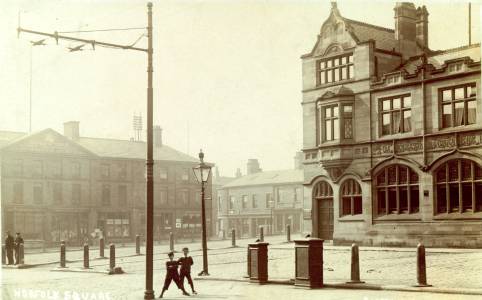
This view of Norfolk Square shows Bank House at the left and the Manchester & County building at the right. |

This view of Norfolk Square shows Bank House at the left and the Manchester & County building at the right. |

Norfolk Square from a different angle showing the Post Office on the corner of Henry Street and the Manchester & County building at the right. |

Barclays Bank at the junction of Norfolk Street and High Street East |

Lloyds Bank, Norfolk Chambers, Henry Street |

The 1880 map shows the Post Office on Henry Street, Bank House and the Savings Bank in the Town Hall |

By 1919 the Post Office had moved onto Norfolk Square and the Manchester & County branch had replaced the earlier buildings |

The location of the original Hadfield Post Office at Bank Bottom is shown on this 1897 map |

The District Bank at the corner of Salisbury Street and Station Road. |